Duchy of Styria
Last updatedDuchy of Styria | |||||||||||
|---|---|---|---|---|---|---|---|---|---|---|---|
| 1180–1918 | |||||||||||
 Map of Austria-Hungary in 1910, showing Styria in red | |||||||||||
| Status | State of the Holy Roman Empire and the Austrian Empire; Kronland of Cisleithanian Austria | ||||||||||
| Capital | Graz | ||||||||||
| Government | Duchy | ||||||||||
| Historical era | Middle Ages | ||||||||||
| 970 | |||||||||||
| 1180 | |||||||||||
| 1192 | |||||||||||
| 1254 | |||||||||||
| 1260 | |||||||||||
| 1276/78 | |||||||||||
| 31 October 1918 | |||||||||||
| 10 September 1919 | |||||||||||
| |||||||||||
| Today part of | Austria Slovenia | ||||||||||
* Transferred by inheritance on the extinction of the ducal line. † Transferred by conquest. | |||||||||||
The Duchy of Styria (German : Herzogtum Steiermark; Slovene : Vojvodina Štajerska; Hungarian : Stájer Hercegség) was a duchy located in modern-day southern Austria and northern Slovenia. It was a part of the Holy Roman Empire until its dissolution in 1806 and a Cisleithanian crown land of Austria-Hungary until its dissolution in 1918.
Contents
History
It was created by Emperor Frederick Barbarossa in 1180 when he raised the March of Styria to a duchy of equal rank with neighbouring Carinthia and Bavaria, after the fall of the Bavarian Duke Henry the Lion earlier that year. Margrave Ottokar IV thereby became the first duke of Styria and also the last of the ancient Otakar dynasty. As Ottokar had no issue, he in 1186 signed the Georgenberg Pact with the mighty House of Babenberg, rulers of Austria since 976, after which both duchies should in perpetuity be ruled in personal union. Upon his death in 1192, Styria as stipulated fell to the Babenberg Leopold V, Duke of Austria.


The Austrian Babenbergs became extinct in 1246, when Duke Frederick II was killed in battle against King Béla IV of Hungary. Styria, a vacant Imperial fief, became a matter of dispute among the neighbouring estates. It passed quickly through the hands of Hungarian kings in 1254, until King Ottokar II of Bohemia conquered it, being victorious at the 1260 Battle of Kressenbrunn. As King Ottokar II had married the last duke's sister Margaret, he laid claim to both Austria and Styria. This met with strong opposition by the newly-elected King Rudolph I of Germany, who claimed the duchies as escheated fiefs. Rudolph finally defeated Ottokar at the 1278 Battle on the Marchfeld, seized Austria and Styria and granted them to his sons Albert I and Rudolf II.
The House of Habsburg provided Styria with dukes of their lineage from that point on. The duchy was, however, separated from Austria by the 1379 Treaty of Neuberg, after which Styria, Carinthia, and Carniola formed the Inner Austrian territory ruled by the descendants of Leopold III of the Leopoldian line, who took their residence at Graz. In 1456 they could significantly enlarge the Styrian territory by acquisition and re-acquisition of the comital Celje estates in Lower Styria. Both duchies were again ruled in personal union, when Leopold's grandson Frederick V inherited Austria in 1457. In 1496 Frederick's son Maximilian I signed an order expelling all Jews from Styria, who were not allowed to return to Graz until 1856. In 1512 the duchy joined the Empire's Austrian Circle.
A second Inner Austrian cadet branch of the Habsburgs ruled over Styria from 1564. Under Archduke Charles II of Inner Austria, Graz became a centre of the Counter-Reformation, expedited by the Jesuits at the University of Graz established in 1585 and continued under Charles' son Archduke Ferdinand II, who became sole rule of all Habsburg hereditary lands and Holy Roman Emperor in 1619. The Protestant population was expelled, including the astronomer Johannes Kepler in 1600. Meanwhile, at the time of the Ottoman invasions in the 16th and 17th centuries after the 1526 Battle of Mohács, the land suffered severely and was depopulated. The Turks made incursions into Styria nearly twenty times; churches, monasteries, cities, and villages were destroyed and plundered, while the population was either killed or carried away into slavery.
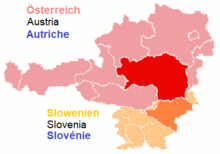
Styria remained a part of the Habsburg monarchy and from 1804 belonged to the Austrian Empire. The development of the duchy was decisively promoted by Archduke John of Austria, younger brother of Emperor Francis I, who in 1811 founded the Joanneum , predecessor of the Graz University of Technology, and the University of Leoben in 1840. He also forwarded the construction of the Semmering railway to Mürzzuschlag and the Austrian Southern Railway line from Vienna to Trieste completed in 1857, which boosted the Styrian economy. In the course of the Austro-Hungarian Compromise of 1867 (Ausgleich), the duchy was assigned as a crown land for the Cisleithanian part of Austria-Hungary, while along with the rise of nationalism the conflict between the German and Slovene population intensified.
On the collapse of Austria-Hungary in the aftermath of World War I, the rump state of German Austria claimed all Cisleithanian Austria with a significant German-speaking population including large parts of the Styrian duchy, while the Slovene Lower Styrian part joined the State of Slovenes, Croats and Serbs. Armed conflicts arose especially around the multilingual town of Maribor (Marburg), until by the Treaty of Saint-Germain-en-Laye (1919) the former duchy was partitioned broadly along ethnic lines, with two thirds of its territory (then called Upper Styria) including the ducal capital of Graz remaining with Austria, and the southern third of Lower Styria with Maribor passing to the Kingdom of Serbs, Croats and Slovenes, eventually becoming part of modern Slovenia.
Name
| History of Austria |
|---|
 |
Styria was attested in historical documents in AD 907 as Styria, in 1191 as Marchia Stirensis, and in 1215 as Marchia Styrie. [1] The name is of pre-Romance substrate origin. The German name Steiermark is a compound; the first element is borrowed from the ancient name Stiria and the second element, Mark, means 'march, border region'. The Slovene name Štajerska and the Czech name Štýrsko are borrowed and adapted from the German name for the region. [1]
Demographics
In 1910 the population of Styria included: [2]
Dukes
Various dynasties
- Ottokar IV (1180–1192), had been the Margrave of Styria since 1164.
- Leopold V of Austria (1192–1194)
- Leopold VI of Austria (1194–1230), son
- Frederick II of Austria (1230–1246), son, killed in battle
- Ottokar II of Bohemia (1251/1260–1278), against
- Béla IV of Hungary (1254–1258) and his son
- Stephen V of Hungary (1258–1260), claimants
House of Habsburg
- Rudolph I (1278–1282), also King of the Romans 1273–1291
- Albert I (1282–1308), son, also King of the Romans from 1298, jointly with his brother
- Rudolph II (1282–1283) and his son
- Rudolph III (1298–1307)
- Frederick the Fair (1308–1330), son of Albert I, jointly with his brother
- Leopold I (1308–1326)
- Albert II (1330–1358), son of Albert I, jointly with his brother
- Otto the Merry (1330–1339)
- Rudolph IV (1358–1365), son of Albert II
- Albert III (1365–1379), son of Albert II, jointly with his brother
- Leopold III (1365–1386), Duke of Inner Austria from 1379
- William (1386–1406), son of Leopold III
- Ernest the Iron (1406–1424), son of Leopold III
- Frederick V (1424–1493), son of Ernest the Iron, also King of the Romans from 1440, Holy Roman Emperor from 1452 and Archduke of Austria from 1457, jointly with his brother
- Albert VI (1424–1463)
- Maximilian I (1493–1519), also Archduke of Austria, Holy Roman Emperor (Emperor-elect) from 1508
- Charles I (1519–1521), also Archduke of Austria, Holy Roman Emperor 1530-1556
- Ferdinand I (1521–1564), also Archduke of Austria, Holy Roman Emperor from 1558
- Charles II (1564–1590), Archduke of Inner Austria
- Ferdinand II (1590–1637), Archduke of Inner Austria, also Archduke of Austria and Holy Roman Emperor from 1619
See also
Related Research Articles

The House of Habsburg, also known as the House of Austria, is one of the most prominent and important dynasties in European history.

Albert I of Habsburg was a Duke of Austria and Styria from 1282 and King of Germany from 1298 until his assassination. He was the eldest son of King Rudolf I of Germany and his first wife Gertrude of Hohenberg. Sometimes referred to as 'Albert the One-eyed' because of a battle injury that left him with a hollow eye socket and a permanent snarl.

The House of Babenberg was a noble dynasty of Austrian Dukes and Margraves. Originally from Bamberg in the Duchy of Franconia, the Babenbergs ruled the imperial Margraviate of Austria from its creation in 976 AD until its elevation to a duchy in 1156, and from then until the extinction of the line in 1246, whereafter they were succeeded by the House of Habsburg, to which they were related.

Carniola is a historical region that comprised parts of present-day Slovenia. Although as a whole it does not exist anymore, Slovenes living within the former borders of the region still tend to identify with its traditional parts Upper Carniola, Lower Carniola, and to a lesser degree with Inner Carniola. In 1991, 47% of the population of Slovenia lived within the borders of the former Duchy of Carniola.

The Duchy of Carinthia was a duchy located in southern Austria and parts of northern Slovenia. It was separated from the Duchy of Bavaria in 976, and was the first newly created Imperial State after the original German stem duchies.

The national flag of Austria is a triband in the following order: red, white, and red.

The Georgenberg Pact was a treaty signed between Duke Leopold V of Austria and Duke Ottokar IV of Styria on 17 August 1186 at Enns Castle on the Georgenberg mountain.

Gertrude of Austria was a member of the House of Babenberg, Duchess of Mödling and later titular Duchess of Austria and Styria. She was the niece of Duke Frederick II of Austria, the last male member of the Babenberg dynasty. She was, according to the Privilegium Minus the first in line to inherit the Duchies of Austria and Styria after the death of childless Frederick, but these claims were disputed by her aunt Margaret.

Albert III of Austria (9 September 1349 – 29 August 1395), known as Albert with the Braid (Pigtail) (German: Albrecht mit dem Zopf), a member of the House of Habsburg, was Duke of Austria from 1365 until his death.
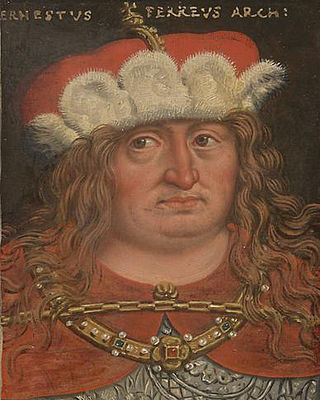
Ernest the Iron, a member of the House of Habsburg, ruled over the Inner Austrian duchies of Styria, Carinthia and Carniola from 1406 until his death. He was head of the Habsburg Leopoldian line from 1411.
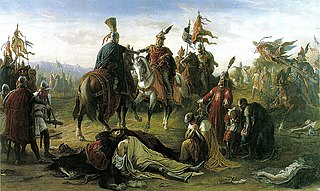
The Battle on the Marchfeld at Dürnkrut and Jedenspeigen took place on 26 August 1278 and was a decisive event for the history of Central Europe for the following centuries. The opponents were a Bohemian (Czech) army led by the Přemyslid king Ottokar II of Bohemia and the German army under the German king Rudolph I of Habsburg in alliance with King Ladislaus IV of Hungary. With 15,300 mounted troops, it was one of the largest cavalry battles in Central Europe during the Middle Ages. The Hungarian cavalry played a significant role in the outcome of the battle.

Inner Austria was a term used from the late 14th to the early 17th century for the Habsburg hereditary lands south of the Semmering Pass, referring to the Imperial duchies of Styria, Carinthia and Carniola and the lands of the Austrian Littoral. The residence of the Inner Austrian archdukes and stadtholders was at the Burg castle complex in Graz.
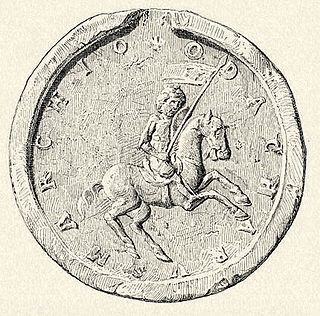
Ottokar IV, a member of the Otakar dynasty, was Margrave of Styria from 1164 and Duke from 1180, when Styria, previously a margraviate subordinated to the stem duchy of Bavaria, was raised to the status of an independent duchy.
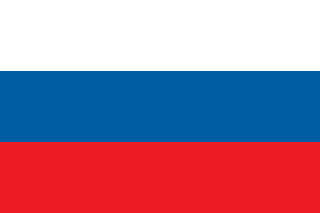
The Duchy of Carniola was an imperial estate of the Holy Roman Empire, established under Habsburg rule on the territory of the former East Frankish March of Carniola in 1364. A hereditary land of the Habsburg monarchy, it became a constituent land of the Austrian Empire in 1804 and part of the Kingdom of Illyria until 1849. A separate crown land from 1849, it was incorporated into the Cisleithanian territories of Austria-Hungary from 1867 until the state's dissolution in 1918. Its capital was German: Laibach, today Ljubljana.

The Archduchy of Austria was a major principality of the Holy Roman Empire and the nucleus of the Habsburg monarchy. With its capital at Vienna, the archduchy was centered at the Empire's southeastern periphery.

The Duchy of Austria was a medieval principality of the Holy Roman Empire, established in 1156 by the Privilegium Minus, when the Margraviate of Austria (Ostarrîchi) was detached from Bavaria and elevated to a duchy in its own right. After the ruling dukes of the House of Babenberg became extinct in male line, there was as much as three decades of rivalry on inheritance and rulership, until the German king Rudolf I took over the dominion as the first monarch of the Habsburg dynasty in 1276. Thereafter, Austria became the patrimony and ancestral homeland of the dynasty and the nucleus of the Habsburg monarchy. In 1453, the archducal title of the Austrian rulers, invented by Duke Rudolf IV in the forged Privilegium Maius of 1359, was officially acknowledged by the Habsburg emperor Frederick III.

The (Princely) County of Tyrol was an estate of the Holy Roman Empire established about 1140. After 1253, it was ruled by the House of Gorizia and from 1363 by the House of Habsburg. In 1804, the County of Tyrol, unified with the secularised prince-bishoprics of Trent and Brixen, became a crown land of the Austrian Empire. From 1867, it was a Cisleithanian crown land of Austria-Hungary.

The Marchof Carniola was a southeastern state of the Holy Roman Empire in the High Middle Ages, the predecessor of the Duchy of Carniola. It corresponded roughly to the central Carniolan region of present-day Slovenia. At the time of its creation, the march served as a frontier defense against the Kingdoms of Hungary and Croatia.

The March of Styria, originally known as Carantanian march, was a southeastern frontier march of the Holy Roman Empire. It was broken off the larger March of Carinthia, itself a march of the Duchy of Bavaria, around 970 as a buffer zone against the Hungarian invasions. Under the overlordship of the Carinthian dukes from 976 onwards, the territory evolved to be called Styria, so named for the town of Steyr, then the residence of the Otakar margraves. It became an Imperial State in its own right, when the Otakars were elevated to Dukes of Styria in 1180.
References
External links
- Map of the Balkans, 1815–59, showing the Duchy of Styria


